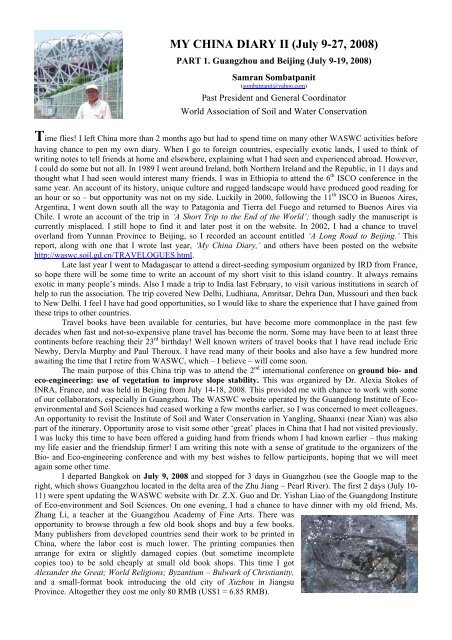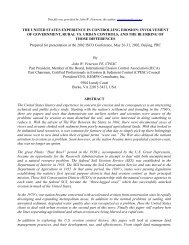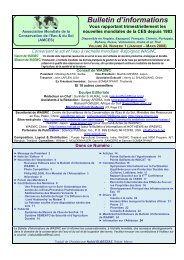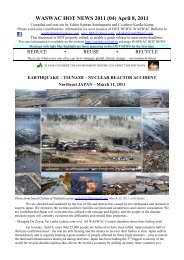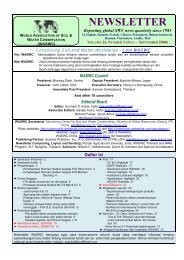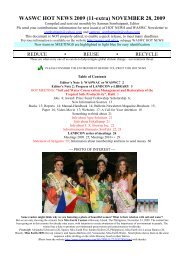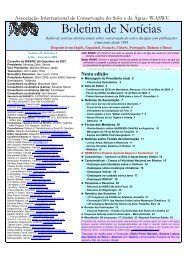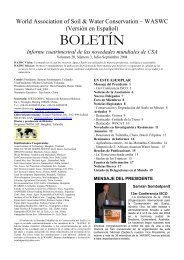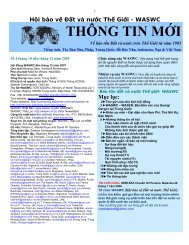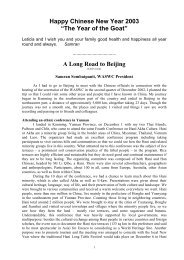MY CHINA DIARY II - World Association of Soil and Water ...
MY CHINA DIARY II - World Association of Soil and Water ...
MY CHINA DIARY II - World Association of Soil and Water ...
You also want an ePaper? Increase the reach of your titles
YUMPU automatically turns print PDFs into web optimized ePapers that Google loves.
From left: View from the window <strong>of</strong> my plane showing the wetl<strong>and</strong> area (fish, shrimp farming) south <strong>of</strong> Suvarnabhumi Airport, on the Gulf<strong>of</strong> Thail<strong>and</strong>; Main building <strong>of</strong> the Guangdong Institute <strong>of</strong> Eco-environmental <strong>and</strong> <strong>Soil</strong> Sciences in Guangzhou, Dr. Yishan Liao who worksas webmaster for the WASWC website in Guangzhou; Ms. Zhang Li, my good friend in Guangzhou; The Eastern Cornucopia Holiday Hotelin Guangzhou where I stayed; View from the window <strong>of</strong> my hotel room; Subtropical <strong>and</strong> tropical fruits in a fruit shop in Guangzhou.Another old friend <strong>of</strong> mine is Dr. Xia Hanping, <strong>of</strong> the South China Botanical Garden –CAS. On July 11, he drove an electric car belonging to the Botanical Garden to take me tolunch with him <strong>and</strong> Pr<strong>of</strong>. Zhian Li, a soil ecologist <strong>of</strong> the same institute. I found that Dr.Xia wanted to show me the newly built <strong>and</strong> soon to be finished glasshouse <strong>of</strong> his institute.He said it was not one, but four combined. The largest one, 7,000 m 2 in area, was the2largest in Asia, if not the world. Of the smaller ones, three <strong>of</strong> them were 1,000 m each.2
From left: Dr. Xia Hanping fetching me with his Garden’s electric car; Taking photos at the South China Botanical Garden (SCBG) withhis colleague, Pr<strong>of</strong>. Zhian Li; And at the Champi Sirindhorn tree (Magnolia sirindhorniae) that Princess Maha Chakri Sirindhorn <strong>of</strong>Thail<strong>and</strong> planted in the Garden in October 2003; The glasshouse (7,000 m 2 , largest in Asia, if not the world) is near completion; Interior <strong>of</strong>the large glasshouse; The same; Me at a very poisonous tree; The <strong>Water</strong>fall; A pitcher plant with a deep pitcher-shaped fluid-filled pouchin which insects are trapped <strong>and</strong> absorbed (many species, chiefly in the family Nepenthaceae); A pleasant walkway in the glasshouse; Asmaller glasshouse for a specific group <strong>of</strong> plants; A happy laborer weeding an area <strong>of</strong> the Garden.The glasshouses should be ready around October 2008 <strong>and</strong> would accommodate many plant species. In the largeglasshouse, besides hundreds <strong>of</strong> varieties <strong>of</strong> plants, there would be various types <strong>of</strong> l<strong>and</strong>scape, namely a stream, awaterfall <strong>and</strong> jungle – plus a c<strong>of</strong>fee shop. The latter was well hidden under an artificial hill <strong>and</strong> could serve at leastone hundred customers at any time. Dr. Xia always shows me some new thing every time we meet!Information about the institute (taken from one <strong>of</strong> its publications): South China Botanical Garden, ChineseAcademy <strong>of</strong> Sciences (SCBG-CAS), formerly known as the Institute <strong>of</strong> Agriculture <strong>and</strong> Forestry, Sun Yat SenUniversity, was founded in 1929 by Chen Huanyong (Woon-young Chun), renowned botanist <strong>and</strong> academician <strong>of</strong>CAS. It was renamed as South China Institute <strong>of</strong> Botany – CAS in 1954, <strong>and</strong> changed to the present name in 2003according to the development strategy <strong>of</strong> CAS. SCGB is one <strong>of</strong> the largest botanical gardens in China. Its nursery<strong>and</strong> exhibition zone occupies an area <strong>of</strong> 282.5 ha. It is designed mainly for plant conservation with over 11,000plant taxa grown in over 30 gardens. These contain special collections such as magnolias, palms, gingers <strong>and</strong>orchids. Inside the garden there are several unique l<strong>and</strong>scapes such as the Magic Forest by Dragon Cave,modern Conservatory Greenhouse <strong>and</strong> Guangzhou oldest village. Address: Xingke Road #723, Tianhe District,Guangzhou 510650, China. bgs@scbg.ac.cn, www.wcbg.ac.cn.On July 12 Dr. Li Dingqiang, director <strong>of</strong> the Guangdong Institute <strong>of</strong> Eco-environmental <strong>and</strong><strong>Soil</strong> Sciences, took me for an outing <strong>and</strong> saw me <strong>of</strong>f to Beijing by train in the evening. Firstlywe went to the birthplace <strong>of</strong> Hong Xiuquan ( 洪 秀 全 ), see left. He was leader <strong>of</strong> the TaipingRebellion (1850-64) in the northern part <strong>of</strong> Guangdong Province. Quoting fromhttp://en.wikipedia.org/wiki/Taiping_Rebellion, he established the Taiping Heavenly Kingdom orHeavenly Kingdom <strong>of</strong> Great Peace with its capital atNanjing <strong>and</strong> gained control <strong>of</strong> significant parts <strong>of</strong> southernChina. At its peak, about 30 million people were being ruledover. I had heard <strong>of</strong> him <strong>and</strong> his movement but this was the first time to visitthe birthplace, currently a museum. Besides learning a bit <strong>of</strong> Chinese history,visitors to the place might also see some interesting folk arts <strong>of</strong> the period one<strong>and</strong> one-half centuries ago. Dr. Li told me the semi-circular pond in front <strong>of</strong> thehouse was unique due to its shape, which he believed was the only such designin this part <strong>of</strong> China.From left: In front <strong>of</strong> the residence <strong>of</strong> Hong Xiuquan, leader <strong>of</strong> the Taiping Rebellion; With Dr. Li Dingqiang in front <strong>of</strong> the statue; Thestatue <strong>of</strong> Hong Xiuquan; Dr. Li <strong>and</strong> an inscribed stone in front <strong>of</strong> the house; The semi-circular pond in front <strong>of</strong> the house; A row houseprobably used by his followers; The main house <strong>of</strong> Hong Xiuquan; Dr. Li in front <strong>of</strong> the entrance to the main house; Me inspecting theearth bricks used to construct a house; Chinese tourists taking photos <strong>of</strong> each other in front <strong>of</strong> the statue.3
From left: Young Hong Xiuquan plowing the rice field with a buffalo; Statue <strong>of</strong> Hong Xiuquan in the building; Two paintings showing himbeing respected like a semi-God; Three paintings showing him during the campaign, when he was very popular among poor peasantfarmers.Household articles <strong>and</strong> furniture in use during 1850s.Our happy hour after the tour <strong>of</strong> Hong Xiuquan’s residence.4
Story <strong>of</strong> Hong Xiuquan: From the base <strong>of</strong> his statue, we learnt thatHong Xiuquan was a native <strong>of</strong> Guanlubu, Hua County, <strong>and</strong> founder <strong>of</strong> theTaiping Heavenly Kingdom. In 1843, he identified himself as God’s secondson, “God’s Chinese Son” <strong>and</strong> organized a group called the GodWorshipers. Afterwards, he went to Guangxi Province to preach with FengYunshan <strong>and</strong> others. In 1851, he led the peasant uprising in Jintian Village <strong>of</strong> Guangxi. Later on, he establishedthe Taiping Heavenly Kingdom <strong>and</strong> proclaimed himself Heavenly King. In 1853, the Taiping forces capturedNanjing which was renamed Tianjing later. In the same year, the l<strong>and</strong>owning system <strong>of</strong> the Taiping HeavenlyKingdom was promulgated. The confrontation between the Taiping Heavenly Kingdom <strong>and</strong> the Qing Dynastylasted until 1864 when Hong Xiuquan died.I was scheduled to take a train from Guangzhou to Beijing that afternoon. We enjoyed the day so much that Ialmost missed the train. When I realized the time <strong>and</strong> our distance from the station that the train would leavefrom, we had only a quarter <strong>of</strong> an hour left! So we had to make a big rush to the station. With the help <strong>of</strong> an oldbut experienced coolie we ‘flew’ past several barricades <strong>and</strong> perhaps a thous<strong>and</strong> other passengers (true, notexaggerating), only to reach the train just before its wheels started to roll. I regret for my lack <strong>of</strong> vigilance, whichcaused so much trouble to my host. Maybe I need to examine myself a bit. The action <strong>of</strong> the old coolie remindedme <strong>of</strong> Aesop’s Lion <strong>and</strong> Rat story.The Guangzhou-Beijing railway is one <strong>of</strong> several trunk routes <strong>of</strong> this country. Swiss engineers came to start theconstruction <strong>of</strong> railways in China in 1895. Since then train travel has become the st<strong>and</strong>ard mode <strong>of</strong> transportationin this country. Compared with European trains, these older iron horses were <strong>of</strong> lower quality but undoubtedlymuch, much better than those in Thail<strong>and</strong> <strong>and</strong> other Asian countries (with exception <strong>of</strong> Japan). For myself, I feelcomfortable traveling everywhere by train in China though my comm<strong>and</strong> <strong>of</strong> Chinese is poor, knowing just fewwords. I prefer to take a hard bed ticket (6 persons in one compartment) whenever these are available. This ismore economical than the s<strong>of</strong>t bed ticket (4 persons in one compartment). I find no problem to climb to the topbed close to the ro<strong>of</strong> <strong>of</strong> the train, but typically a fellow traveler will always be kind to let me exchange the bedwith his or hers, if that is the case. In certain cases I can also take a seat ticket, which reduces my budget a lot,with the bonus <strong>of</strong> getting to know some local Chinese people. That night I read the book Xuzhou to its end.From left: Upper row: A corridor on the train Guangzhou-Beijing; A girl enjoying her breakfast; A boy staring at my camera; A trainconductor collecting garbage <strong>and</strong> gathering recyclable materials at the same time; A male conductor sweeping the floor <strong>of</strong> the corridorafter the meal; Restaurant personnel bringing fruits from lower latitudes in Guangzhou to sell to passengers who might want to givepresents to their relatives in Beijing. Lower row: Boy performing Kung Fu after I asked him – which he enjoyed very much, as did otherpassengers.July 13, I woke up just before a vendor arrived with a pot <strong>of</strong> hot porridge, so I enjoyed one bowl, which cost just5 RMB. The train had already passed Zhengzhou <strong>and</strong> would continue on to Shijiazhuang to arrive at Beijing earlyin the afternoon. A very small boy came around so I asked him to demonstrate me Kung Fu, which he did verywell. It seems everyone in this country knows this kind <strong>of</strong> martial art. I had planned to visit Shaolin Temple inHenan Province on the final leg <strong>of</strong> this trip. Kung Fu originates in China <strong>and</strong> study <strong>of</strong> this martial art is still beingencouraged everyday.5
Before reaching Beijing the train ran past a large plain growing corn, beans <strong>and</strong> other field crops, which has goodirrigation <strong>and</strong> attains high yields. I have traveled this route quite <strong>of</strong>ten, so the vast l<strong>and</strong>scape <strong>of</strong> the North ChinaPlain is now quite familiar to me. If I pass this route in autumn, it is nice to see a lot <strong>of</strong> corn left to dry in thesunlight on the flat concrete ro<strong>of</strong>s <strong>of</strong> houses along the rail line.The train pulled in at the Beijing West station (known to be the largest railway station in Asia) where I took a taxito the Jade Palace Hotel in the northern part <strong>of</strong> the city. This hotel was close to the meeting venue <strong>of</strong> the Bio- <strong>and</strong>Eco-engineering conference, to be held the next day.From left: A high speed train <strong>of</strong> China – CHR = China High-speed Rail – while stopping at a station en route to Beijing; Fields growingcorn <strong>and</strong> other crops along the railway; A large corn field; Trees are grown along the railway <strong>and</strong> highway; Beijing West Station, thelargest train station in Asia; Jade Palace Hotel, my residence in Beijing this time.After checking in, I did not wait long before finding my way to the center <strong>of</strong> the city. The nearby train station ZhiChun Lu serves Line 13 (aboveground train) <strong>and</strong> connects with the Line 2 underground train. There, passengerscan transfer to the Line 1 underground train that traverses the city center. Coming to Beijing this time I found theyhave changed to new trains, to welcome the 29 th Olympic Games. To lessen the use <strong>of</strong> personal vehicles <strong>and</strong>reduce pollution, the city has encouraged its people to use public transport by reducing the fare <strong>of</strong> the whole trainsystem within Beijing to only 2 RMB, a real gift to the visitors!It took me almost one hour to reach a new Beijing theater, called the National Centre for the PerformingArts. The theater opened last year but it is so new that many people go there for sightseeing. I went in to find outif there was any performance that I could attend. Inside the half-egg-shaped dome I found that there was not onetheater but at least three. There was one on the east side, acting as a Concert Hall, one on the west side for drama<strong>and</strong> a large one in the middle for opera. The three theaters were well separated from each other. There was noperformance in the Concert Hall, so I bought a ticket to see Merchant <strong>of</strong> Venice. Then I found that Aida was alsobeing performed in the Opera House on the same evening. I had never seen Aida before <strong>and</strong> had hoped to see it,notably the impressive Aida March. So such a chance disappeared <strong>and</strong> don’t know if it will come again.I admit that when I chose to see the Merchant <strong>of</strong> Venice it was ONLY to get to see inside the DramaticTheater. The performing artists belonged to an American company; they talked <strong>and</strong> sang in English, with Chinesesubtitles shown on both sides. It was full house today though the tickets were not cheap. I paid 380 RMB for myseat in a middle row! I believe some <strong>of</strong> the audience were not there to enjoy the play but rather to view theappearance <strong>of</strong> the theater. I noticed one Chinese family who decided to walk out only after a few minutes. Itseemed a pity that the more than 1,000 RMB they had paid for entering such a prestigious place did not providemuch return. The play lasted less than two hours, with one intermission. Then I walked around inside the wholedome, where they have arranged some theatrical exhibitions for visitors. These included how the present NationalCentre for the Performing Arts was planned <strong>and</strong> constructed, with the groundbreaking taking place early thiscentury. Before leaving, I bought a few CDs that were issued as a commemorative set <strong>of</strong> this great architecturalmarvel. They should make good presents for friends. See the performance programs <strong>of</strong> all theaters at the Center(in Chinese only) at www.chncpa.org.6
From left: Zhi Chun Lu train station serving Line 13 <strong>of</strong> the Beijing train system; New trains were introduced to replace the old ones on theoccasion <strong>of</strong> the 29 th Olympiad; In front <strong>of</strong> the National Centre for the Performing Arts; Posters showing some performances to take place inthe three theaters within this dome-shaped structure: Dramatic Theater, Opera House <strong>and</strong> Concert Hall; A couple taking a photo in front<strong>of</strong> the Aida opera poster; Poster showing an old Chinese play – Jinzi.I admit that I enjoy western types <strong>of</strong> performing arts, especially opera. Though not equipped with lots <strong>of</strong> money,when traveling abroad I used to take the opportunity to visit theaters or opera houses <strong>of</strong> note. I saw Bizet’sCarmen at the Opera House in Paris with real horses galloping on stage; that was as early as 1967. Otherperformances I have seen include Madame Butterfly by Puccini at the Stockholm <strong>and</strong> Prague opera houses, withFidelio by Beethoven at Covent Garden in London, to name but a few.On the way back I had a chance to look around, while walking from the train station to the hotel. In fact, travelingin China is relatively safe, perhaps because <strong>of</strong> strict laws with severe punishment. But one should not always trustthe relatively calm situation. I was once held captive in a beautiful city <strong>of</strong> China. I was threatened <strong>and</strong> had to partwith some money just to regain my freedom. I hope to have a chance to write about this short episode later.July 14, 2008. Today the conference will start. The conference venue is just a few minutes away. The NationalCenter for International Research in LIAMA (Sino-French Laboratory for Computer Science, Automation, <strong>and</strong>Applied Mathematics) (or Institute <strong>of</strong> Automation) that belongs to the Chinese Academy <strong>of</strong> Sciences is on the 11 th<strong>and</strong> 12 th floors <strong>of</strong> a beautiful building (see below). While the room for our bio- <strong>and</strong> eco-engineering meeting is onthe 13 th floor (Chinese have no problem with number 13), the top level. This was the first time I would meet Dr.Alexia Stokes, so it was an exciting moment. Actually we had had a continued correspondence over the past 4years, since the 1 st meeting on eco-engineering in Thessaloniki, Greece, in 2004. We found we had a commoninterest in using plants to stabilize slopes, especially in non-agricultural areas, which is both cheaper <strong>and</strong> muchmore visually-attractive.Foreign delegates formed the majority <strong>of</strong> participants today, while Chinese colleagues were in small number. Thisis the opposite <strong>of</strong> what might be expected in Thail<strong>and</strong>. I had met a number <strong>of</strong> foreign delegates before, namelyAlex Watson from New Zeal<strong>and</strong> <strong>and</strong> Doug Wimble from Australia. They attended the Bioengineering conferencein Manila in 1999, while I’d met Gernot Fiebiger from Austria at the Debris Flow conference in Taipei in Octoberlast year. Jean Poesen had attended the BORASSUS conference in Chiang Mai, Thail<strong>and</strong> early this year. Reunionwith friends made the friendships firmer <strong>and</strong> meeting new friends would make something new happen!7
From left: National Center for International Research in LIAMA (Sino-French Laboratory for Computer Science, Automation, <strong>and</strong> AppliedMathematics) (or Institute <strong>of</strong> Automation), belonging to the Chinese Academy <strong>of</strong> Sciences, is on the 11 th <strong>and</strong> 12 th floors. Our Bio- <strong>and</strong> Ecoengineeringmeeting was held on the 13 th floor.Altogether there were almost 50 papers presented during the 3½ days <strong>of</strong> the conference. Can you see yourself?Conference opening: Alexia has worked with her Chinese colleagues at this institute for over 2 years <strong>and</strong> thisconference seems to be the project conclusion. After she had made a short introduction to the conference, DirectorTianzi Jiang gave an opening speech, to be followed by Doug Wimble, talking on behalf <strong>of</strong> the IECA(International Erosion Control <strong>Association</strong>). Gernot gave a speech on IUFRO’s behalf. I then gave a speech onWASWC’s role in promoting soil <strong>and</strong> water conservation worldwide, especially by using plants. This wasfollowed by a PPT presentation about the recent earthquake in Sichuan Province. It had been prepared by Pr<strong>of</strong>.Peng Cui who could not come. The PPT (http://waswc.soil.gd.cn/<strong>Soil</strong>ErosionNSWC.html) clearly identified thelocations <strong>of</strong> quakes <strong>and</strong> results in terms <strong>of</strong> damage <strong>and</strong> injuries. The death toll was almost 70,000, with millions <strong>of</strong>homes being destroyed.8
Pictures from the Sichuan earthquake on May 12, 2008, as shown at the conference opening. The PPT is available on the WASWC website.We should all congratulate Pr<strong>of</strong>. Peng Cui <strong>and</strong> his colleagues from the Institute <strong>of</strong> Mountain Disaster <strong>and</strong>Environment – CAS in Chengdu. They had laboriously prepared this valuable set <strong>of</strong> 70 slides as an importanthistorical record. At the time <strong>of</strong> the meeting, the staff members from this institute were still helping in the rescue<strong>of</strong> the injured <strong>and</strong> rehabilitation <strong>of</strong> the quake areas. Constant risks remained due to several lakes formed by theearthquake.CONFERENCE OVERVIEWThe conference went on ‘as usual’ for 4 days, with activities such as:An ice-breaking drink session around the posters on the evening <strong>of</strong> Monday, July 14, 2008.In the afternoon <strong>of</strong> Tuesday, July 15, 2008, the group went to the Beijing Botanical Garden.In the evening <strong>of</strong> Wednesday, July 16, 2008, all went to attend a banquet at the famous Bai Jia Da Yuan RestaurantThe conference ended in the evening <strong>of</strong> Thursday, July 17, 2008. Alexia said goodbye to all participants.Whole day Friday, July 18, 2008, many but not all went to tour the Great Wall <strong>and</strong> Ming Tombs.The conference was well attended by participants from both the west <strong>and</strong> east. Several had attended the firstmeeting in Thessaloniki in 2004, so it created a nice atmosphere when the organizers (particularly Alexia Stokes<strong>and</strong> her husb<strong>and</strong> Thierry Fourcaud) met with acquaintances once more. Among them was a group <strong>of</strong> eight peoplefrom Greece, plus another good friend formerly from Macedonia (I teasingly called them the Pan-Hellenic groupduring social functions).During the conference, each person was allowed 20 minutes to cover their talk <strong>and</strong> to answer a few questions. Ithink all <strong>of</strong> them, including myself, had used the Powerpoint computer program to present their work. I mustcongratulate Bill Gates once more for having created a good product for the academic community to use inadvancing their pr<strong>of</strong>ession. I always admire <strong>and</strong> thank him, since his innovations <strong>of</strong> Windows <strong>and</strong> Micros<strong>of</strong>tOffice allowed our association to serve members in 10 languages! Another person to admire (<strong>and</strong> even more thanBill Gates) is the US computer engineer Mr. Ray Tomlinson, who invented internet-based e-mail some 37 yearsago http://inventors.about.com/od/estartinventions/a/email.htm. Such an innovation, <strong>and</strong> its present impact, shouldbe worthy <strong>of</strong> earning the inventor a Nobel Prize, since it has been said that that no one during their active lifecould avoid using the internet <strong>and</strong> e-mail. Altogether, there were almost 50 papers presented, with around 10papers by authors who could not make it to the event. Papers were arranged into the following sessions:- <strong>Soil</strong> mass movement <strong>and</strong> vegetation (I, <strong>II</strong>)- Erosion processes, soil conservation <strong>and</strong> vegetation- Ecology, biodiversity <strong>and</strong> restoration after disturbance (I, <strong>II</strong>)- Ground bio- <strong>and</strong> eco-engineering tecniques (I, <strong>II</strong>, <strong>II</strong>I)- <strong>Soil</strong> hydrology <strong>and</strong> integrated catchment management- Modelling <strong>of</strong> slope stability (I, <strong>II</strong>)- Mitigation, management <strong>and</strong> the future9
In addition, there were some 30+ posters, half <strong>of</strong> them presented in the first 2 days <strong>and</strong> the other half during thelast 2 days. These posters served their purpose well, <strong>and</strong> I have noted some very good titles among them. Paperspresented at this conference will be selected for publication in special issues <strong>of</strong> Ecological Engineering (Elsevier)<strong>and</strong> Plant <strong>and</strong> <strong>Soil</strong> (Springer). Readers interested in knowing more about papers at this conference <strong>and</strong> the specialissues may contact the secretary Ms. Hong Bizhen at bzhong@nlpr.ia.ac.cn.A 53-minute video entitled “Lessons <strong>of</strong> the Loess Plateau” was shown to participants onthe first day after the ice-breaking. This was compiled as part <strong>of</strong> the EnvironmentalEducation Media Project (EEMP), Beijing. The director, John Liu (johnliu@eempc.org),came to present it himself. The video shows what development personnel should do in theirwork on the Chinese Loess Plateau. Ideas could be applied to other damaged ecosystems.The video can be viewed at www.earthshope.org.Some conference participants, just before leaving for the Beijing Botanical Garden on July 15, 2008.On July 15 afternoon, we went to the Beijing Botanical Garden, which is located on the west side <strong>of</strong> the city. Ashort history is given below. I had planned to visit the Beijing Botanical Garden sometime ago. By including thistrip in the conference program, it became a double treat. So I greatly appreciated the organizers’ planning.At the Institute <strong>of</strong> Botany (CAS) we passed buildings that are being used as <strong>of</strong>fices <strong>and</strong> a herbarium. We weretaken around the arboretum, gardens <strong>and</strong> glasshouses. The following photos were taken during this short trip <strong>of</strong>little more than one hour.With digital photography, we were able to gather a lot <strong>of</strong> informationwithin a short time. In one building I took a photograph <strong>of</strong> a SouthAmerican water lily <strong>and</strong> its descriptive plate. I later realised thatmisspelt English words (typos) are still common in China, e.g.‘Vitoria amarzonica’ (wrong) instead <strong>of</strong> ‘Victoria amazonica’ (right). A photo <strong>of</strong> V. amazonica in a glasshouse <strong>of</strong>the Institute <strong>of</strong> Botany is shown here. You can compare this with one in Japan, that can comfortably support achild sitting on its huge leaf (only needing some help in spreading her weight).10
From left: Office building <strong>of</strong> the Institute <strong>of</strong> Botany – CAS, a large part <strong>of</strong> it is the herbarium; Stone pillars <strong>of</strong> the Institute; A pleasantwalkway within the arboretum; A large juniper; Flowers <strong>of</strong> crepe myrtle; Daylily, an edible flower; Victoria lily, an Amazonian water plantwhose leaf can carry the weight <strong>of</strong> a child, the last photo is from Japan.Next, we stopped at one glasshouse <strong>and</strong> our Austrian friend, Gernot Fiebiger, told us that inhis country such a cactus, with many long, hard <strong>and</strong> sharp thorns, is called a ‘mother-in-law’sstool’. Many <strong>of</strong> us laughed on hearing that but agreed that such a name was apt! I rememberwe have perhaps a hundred <strong>of</strong> them at the glasshouse <strong>of</strong> the Queen Sirikit Botanic Garden inChiang Mai, northern Thail<strong>and</strong>. (Note: In Thail<strong>and</strong> we say ‘Botanic Garden’, rather than‘Botanical Garden’, as is the practice in China.)After crossing a road we were in the Botanical Garden proper. There are many gardens inside <strong>and</strong> I think it’sbetter to spend one full day there. I took a number <strong>of</strong> photos to show friends.11
From left: Large stone with the name <strong>of</strong> the Beijing Botanical Garden at its entrance; Zhuo (Growing Strong) – the sculpture initiallycreated by Japanese sculpturist Mitsuaki Sora to mark the 30 th anniversary <strong>of</strong> the formalization <strong>of</strong> China-Japan diplomatic relationship in2002. It was exp<strong>and</strong>ed in 2007 to symbolize the friendship <strong>of</strong> five continents under the Olympic flag; Pleasant pedestrian path inside theGarden, with many pictureque Salix matsudana (or Pendula) trees; A typical bridge <strong>of</strong> ancient design; Glazed Arch constructed during thereign <strong>of</strong> Emperor Qianlong which has four pillars, three arches <strong>and</strong> a single-layer saddle ro<strong>of</strong> made <strong>of</strong> yellow glazed tiles. Decorated witholivine tiles, it looks all the more exquisite <strong>and</strong> gorgeous, reflecting the tremendous momentum <strong>of</strong> the royal temple in the Qing Dynasty.Inlaid on the arch is the glazed design <strong>of</strong> “Two Dragons Frolicking with a Pearl”, the images being vividly brought to life. Tthe characters“Tong Can Mi Zang” are engraved on the façade <strong>of</strong> the arch, with the characters “Ju Zu Jing Yan” on the rear surface. These werewritten by Emperor Qianling himself; A monument showing where the 40ºN latitude line passes.From left: Walking along the Wangfujing pedestrian street at night, there are many shops; Century-old gift shop; A shop selling clothes;Wangfujing snack street catering all types <strong>of</strong> food, especially from remote areas <strong>and</strong> some strange food like roasted scorpions.We arrived back not too late, so I took the chance to go for a stroll alone along Wangfujing walking street,looking at the century-old giftshop. I bought some souvenirs, tried some local foods at a branch street <strong>and</strong> boughtsome English books at the Beijing Foreign Languange Bookshop. I got several good books this time, includingone that describes all the <strong>World</strong> Heritage Sites in China (except the last one – the clayhouses in Fujian Province) –then I went back to the hotel.On the evening <strong>of</strong> July 16 we were advised that the restaurant for our conference banquet was only 7 minutesaway by car or 25 minutes if we wanted to walk. While I preferred walking but I did not want to risk this special12
event by getting lost; so I went with the group in one <strong>of</strong> the two organized buses. Along the way, we saw a lot <strong>of</strong>digital technology enterprises, being dubbed the Silicon Valley <strong>of</strong> Beijing.I quote from the restaurant brochure: “The Baijiadayuan Restaurant lies within the famous “Yuejia Garden”, inSuzhou Street, Haidian District, Beijing. It is famous for imperial court cuisine <strong>and</strong> the unique Baifu dishes. Therestaurant is in the garden style <strong>of</strong> the Qing Dynasty. It has successively won such honors as the “NationalSpecial Grade Restaurant”, “Four star Level Tourism Hotel”, Famous Restaurant <strong>of</strong> China”, “Chinese StyleCharacteristic Hotel” <strong>and</strong> “Reliable Enterprise”.The garden where the restaurant is located was once the residence <strong>of</strong> Prince Li <strong>of</strong> the Qing Dynasty. It was builtin the reign <strong>of</strong> Emperor Kangxi by the <strong>of</strong>fspring <strong>of</strong> Prince Li who was the second son <strong>of</strong> the first emperor <strong>of</strong> theQing Dynasty, Nu’erhachi. Daishan (Prince Li) was one <strong>of</strong> the founding fathers <strong>and</strong> leader <strong>of</strong> the Zhenghong Qi(one <strong>of</strong> the “Eight Banners”, the military administrative organizations <strong>of</strong> the Manzu nationality). He wasconferred as the chief <strong>of</strong> the powerful <strong>and</strong> renowned “Eight Iron Crown Kings”. Ten <strong>of</strong> his posterity succeeded tohis rank. In the early period <strong>of</strong> the Republic <strong>of</strong> China, this garden was shifted to the Yue family, the owner <strong>of</strong>Tongrentang Pharmacy, <strong>and</strong> renamed Yue Jia Garden”.“As you walk into the restaurant, leisurely ancient music is lingering <strong>and</strong> reverberating in the air, <strong>and</strong> thefragrance <strong>of</strong> flowers <strong>and</strong> grasses is prevailing here <strong>and</strong> there. By a squatting down (ancient form <strong>of</strong> etiquette) <strong>and</strong>an ancient greeting “Nin Ji xiang” (meaning “Good luck to you”), the maid holding a silk h<strong>and</strong>kerchief leads youinto this poetic <strong>and</strong> picturesque wonderl<strong>and</strong>. The garden restaurant, with its Qing Dynasty styled garden,architechtures, habiliments, etiquette, music, <strong>and</strong> cate, creates an impressive cultural atmosphere, which makesthe guests comfortable <strong>and</strong> forget to leave. Welcome to appreciate the catering culture <strong>of</strong> the Qing Dynasty here.It’s a symbol <strong>of</strong> your nobleness”.From left: Entrance gate to the Yuejia Garden Restaurant; Every participant seems to carry a camera; An actor or actress at the show?; Alovely maid examines her photo in the camera <strong>of</strong> our Bhutanese friend Tshering Dorji; A good cheer <strong>of</strong> the Pan-Hellenic Group; A lovelymaid shares a happy moment with Alexia <strong>and</strong> me; Congratulatory speeches from participants; Maids appear in ancient colorful costumes;They say ‘ch-e-e-se’ – when two old friends take a photo together (I heard Chinese would say ‘to-fu’ for the same purpose); Hong Bizhen<strong>and</strong> Walter Chen being served; A friendly chat between two Balkan friends, Ioannis Spanos <strong>and</strong> Slobodan Mickovski; The entrance-exit <strong>of</strong>the restaurant is beautifully lit at night.As indicated in the brochure, components <strong>of</strong> this restaurant are various, not just material cuisine, but also food forthought. By the end <strong>of</strong> the banquet, all participants had enjoyed the evening enormously <strong>and</strong> we left for the hotelfully satisfied.13
Doug Wimble, Geeta Shrestha Vaidya <strong>and</strong> meLate afternoon <strong>of</strong> July 17: It was the closing session <strong>and</strong> time to say good-bye. These are the words <strong>of</strong> Alexia,who chaired the final session: “The 2 nd International Conference on ‘Ground Bio- <strong>and</strong> Eco-engineering. The Use<strong>of</strong> Vegetation to Improve Slope Stability’ was held in Beijing, China, 14-18 July 2008. Over 100 participantsattended, representing 22 countries. Scientists <strong>and</strong> practitioners had met together to discuss subjects areasranging from plant root-soil interactions to large-scale mass wasting processes <strong>and</strong> restoration measures. In anera where more <strong>and</strong> more natural hazards are occurring, soil erosion, l<strong>and</strong>slides <strong>and</strong> other catastrophic eventsresult not only in the loss <strong>of</strong> lives <strong>and</strong> infrastructure, but cause major damage to the environment. The aim <strong>of</strong>these meetings therefore is to bring together scientific researchers, practitioners, geotechnical <strong>and</strong> civilengineers, biologists, ecologists <strong>and</strong> foresters to discuss current problems in slope stability research, <strong>and</strong> how toaddress those problems using ground bio- <strong>and</strong> eco-engineering techniques. The next conference will be held inVancouver, Canada in 2012. Further information will be available at: http://icgbe2.cirad.fr/. Bye-bye.Doug Wimble <strong>and</strong> I had dinner together in the evening. We shared a feeling that co-operation by WASWC <strong>and</strong>IECA should benefit many aspects <strong>of</strong> conservation <strong>of</strong> both agricultural <strong>and</strong> non-agricultural l<strong>and</strong>. We will proposeto each council that WASWC <strong>and</strong> IECA should cooperate over certain activities, e.g. organizing technicalmeetings. I see benefits <strong>of</strong> such a venture, since both WASWC <strong>and</strong> IECA have a global m<strong>and</strong>ate <strong>and</strong> areas <strong>of</strong>interest can complement each other very well.[Earlier in the day, I had a lunch meeting with Henry Lu Shunguang, ourExecutive Secretary <strong>and</strong> we agreed on founding the work <strong>of</strong> WASWC in Chinaat Beijing, Yangling (near Xian – see Part 2 <strong>of</strong> this Diary) <strong>and</strong> Guangzhou. Wemay thus call this the China Triangle, to correspond with the India Triangle <strong>of</strong>Delhi-Ludhiana-Dehra Dun. Also on Tuesday, July 15, I met Li Hui, a student <strong>of</strong>Pr<strong>of</strong>. Li Hongwen <strong>of</strong> China Agricultural University in Beijing. We discussedvarious matters; I found her to be an intelligent student. At the same time, money thatWASWC members had donated to help Sichuan earthquake victims was given to theorganizers.]July 18, 2008. At breakfast I met a participant who was considering writing a text book on <strong>Soil</strong> Bioengineering.Earlier I had announced that WASWC was interested in publishing such manuscripts for general readers,including students. There are several ways to disseminate such knowledge. One way is to publish material as alow-cost text book, like the title No-Till Farming Systems. This was launched at the beginning <strong>of</strong> 2008, <strong>and</strong> morethan 9,000 copies have been circulated already.After breakfast John Liu came to take me to his residence in the eastern part <strong>of</strong> the city. On the way wepassed the Bird Nest, which was to be the main stadium for the 29 th Olympiad in less than 3 weeks. I saw manypeople walking around the area. I said to myself, “I must come here tomorrow with my guide.”John called his house a ‘cottage’, while I preferred to think <strong>of</strong> it as a mansion, because it has many rooms. Therewas a courtyard in the middle, <strong>and</strong> with a good-sized gazebo to house a dozen people or so. I met his wife Kosimawho helps administer the Environmental Education Media Project (EEMP), an NGO. After that I was allowed towork with John’s computer to respond to the many e-mails that had accumulated during the past week.I met John’s parents over lunch, both being senior citizens in good health. When I meet older but veryhealthy people, I only wish that I could manage the same – but who knows! John built this house 18 years agowhen the family moved from America <strong>and</strong> some rebuilding had been required. Photos below show John’sresidence.14
From left: A wooden blind just behind the entrance gate <strong>of</strong> John’s house; Me in discussion with John in his garden; With John <strong>and</strong> his wifeKosima; Branches <strong>of</strong> a tree that belongs to a subspecies <strong>of</strong> Robinia pseudoacacia (false acacia) - popular among Beijing people; Aspacious gazebo in the middle <strong>of</strong> John’s courtyard; The interior <strong>of</strong> the gazebo; The moongate separating between the entrance gate <strong>and</strong>inner part <strong>of</strong> the house; The place where solace can be found during stressful times, in company with the image <strong>of</strong> Lord Buddha.I had a chance to learn something more <strong>of</strong> John’s activities. Being a Rothamsted Fellow for Communication <strong>of</strong>Science, he travels very <strong>of</strong>ten to give lectures about the environment <strong>and</strong> l<strong>and</strong> degradation in many countries.With such ability he could attract funding quite easily. I lack his skill – failing to attract donors to what I havebeen doing reflects a weak point.John gave me more CDs, which I intend to put in HOT NEWS, as we have readers in many disciplines. Then hedrove me to the train station at Sihui, <strong>and</strong> I traveled to Tiananmenxi to meet a friend at the new Beijing Theater.Traveling in Beijing this time is worry-free moneywise, as the government had reduced the price <strong>of</strong> the subwayticket to only 2 yuan for the whole system, a part <strong>of</strong> the attempt to curb air pollution during the Olympics.I met D<strong>and</strong>an in Suzhou last year <strong>and</strong> before I came to Beijing I made an appointment with her so we could go toa concert together. Today is a good day for both her <strong>and</strong> me. She is a data analyst <strong>and</strong> has to work quite hard.Just after 6.00 pm D<strong>and</strong>an came to meet me in front <strong>of</strong> the new theater, apologizing for being late. Chinese arequite punctual. This is a respectable quality that I used to lack – but I am honest enough to admit it, am I not? Butthis time I became her guide, as she had never been to this place before despite being a Beijing resident. At thattime the theater had been in operation for more than one year.From left: A Chinese lady taking a photo <strong>of</strong> her friend in front <strong>of</strong> the Beijing new theater; D<strong>and</strong>an shows a cloth bag thatfeatures a koala, one <strong>of</strong> her presents from Thail<strong>and</strong>; D<strong>and</strong>an at the cinema snack shop; A movie advertisement for Red Cliff.We checked all theaters in the building, the opera house, theatre <strong>and</strong> concert hall but none had any tickets left. SoI suggested going to the nearby Beijing Concert Hall but we were disappointed once more. Then we realized it15
was a Friday, so most people have finished their weekly job <strong>and</strong> wanted to relax. As a result all the entertainmentvenues were full.I asked D<strong>and</strong>an to suggest what local entertainment may suit such situation. Then she took me to see the Chinesefilm Red Cliff at a cinema in a shopping mall on the east side <strong>of</strong> the city. This was only part 1 <strong>of</strong> the movie, whilepart 2 will be released in October. Fortunately, there were English subtitles, so I could underst<strong>and</strong> it to someextent <strong>and</strong> I realized it was a good movie. One thing was shown clearly; the troop (in the movie) used the turtleshell battle strategy that Alex<strong>and</strong>er the Great devised more than 23 centuries ago <strong>and</strong> could conquer enemy troopsagain <strong>and</strong> again.We parted at a train station on Line 2 close to her home, where she stayed with her auntie. We promised to meetagain in the future <strong>and</strong> will find a way to attend a performing art <strong>of</strong> our choice.July 19, this was to be my last day in Beijing; I would take a train to Dalian on the east coast this evening. My oldfriend Wang Zhaoyan came to meet me at 9.00 AM, announcing she had got her Ph.D. in Forest Ecology fromBeijing Forestry University yesterday. I congratulated her with one light hug. Chinese ladies can be more reservedin the way they greet a person <strong>of</strong> the opposite sex, by comparison with the situation in the west. People who havespent sometime in the west may behave differently. The first time I met Zhaoyan at the 2002 ISCO conference,she was a student recruited to assist the organisers in performing various activities. I met her again in 2004, in2006 <strong>and</strong> 2007.Zhaoyan came with the same car <strong>and</strong> driver that we had benefited from over the last two years. Today we plannedto go to 2-3 places in Beijing; the first one was obviously the Bird Nest. The car left us near the Dragon Building(Bangkok has Elephant Building, not far from my house). We crossed the pedestrian bridge to the other side <strong>and</strong>walked along the hurricane fence to see at least two sides <strong>of</strong> the stadium. They had security people guarding thearea tightly. There were many people coming to walk in the direction <strong>of</strong> the entrance. We walked around for alittle more than half an hour, took many photos <strong>and</strong> got into the car that came to fetch us at the end <strong>of</strong> thepathway. Photos below show something <strong>of</strong> the Olympic stadium <strong>and</strong> people around it, mostly Chinese. ThisOlympic stadium has really attracted a lot <strong>of</strong> people <strong>and</strong> will remain popular even after this great athletic eventhas passed.From left: The Dragon Building, close to the Olympic stadium; Tourists looking at the Bird Nest stadium, the main stadium for the 29Olympiad; Me with Wang Zhaoyan; A security personnel guarding the Olympic stadium; Wang Zhaoyan in front <strong>of</strong> the Olympic stadium(inset: a lovely Hibiscus flower found nearby; Young students asking questions <strong>of</strong> foreign visitors about their attitude towards Beijing, <strong>and</strong>especially the arrangement <strong>of</strong> the Olympics; Tourists gather in front <strong>of</strong> the entrance gate; A tourist guide leading her customers outside thehurricane fence that guards the Olympic stadium area.From the Bird Nest, Zhaoyan brought me to the Dongyue Temple ● Beijing Folk Custom Museum, located at141 Dongyuemiao, Chaowaidajie, Chaoyang District, Beijing.16th
According to the description at the temple: The temple was first built by Taoist monks in the 6 th year <strong>of</strong> the Yanyoureign period <strong>of</strong> Yuan Dynasty in 1319. The Dongyue Temple occupied an area <strong>of</strong> more than 6 hectares (15 acres),with 376 rooms during its prime. Only 500 m east <strong>of</strong> Chaoyangmen subway station, it is in the center <strong>of</strong> thebusiest part <strong>of</strong> Beijing, the temple is the largest in north China <strong>of</strong> the Zhengyi school <strong>of</strong> Daoism. Now it is one <strong>of</strong>National Key Cultural Relics Protection Units in addition to the Beijing’s most delightful scenic spots.In history, the Dongyue Temple was built for <strong>of</strong>fering sacrifice to gods or ancestors on a national scale. Thesacred folk celebrations are more splendid, <strong>and</strong> now the Dongyue Temple, a valuable cultural <strong>and</strong> historicheritage site becomes the cultural activity center <strong>of</strong> pr<strong>of</strong>ound cultural backgrounds in terms <strong>of</strong> folk custom. Afterits restoration, it is used as the Beijing Folk Custom Museum.Beijing Folk Custom Museum is the only one in Beijing that can hold national exhibitions focusing on folkcustoms.From the very beginning, many large fairs regarding folk customs <strong>of</strong> old Beijing were held here. Every SpringFestival, as well as other traditional festivals like the Dragon Boat Festival, the Mid-autumn Festival (15 th day <strong>of</strong>the 8 th lunar month), <strong>and</strong> the Double Ninth Festival, people gathered in the temple to celebrate various wonderfulfolk activities.The Dongyue Temple ● Beijing Folk Custom Museum is a window for you to know <strong>and</strong> to underst<strong>and</strong> Beijing.From left: The principal stele <strong>of</strong> the Dongyue Temple; A guard <strong>of</strong> the Temple gate; These red tapes are put on the fence <strong>of</strong> a tree for goodluck; Plan <strong>of</strong> the Temple ground; Me at a large stele that has an animal figure under it; A gate under the false acacia, Robiniapseudoacacia, which is in full bloom everywhere in Beijing <strong>and</strong> its environs (this street has the largest number <strong>of</strong> trees in the capital city);The main temple building; A collection <strong>of</strong> steles; Wang Zhaoyan in an upstairs corridor <strong>of</strong> the folk museum.A local restaurant where we had lunch; Flowers <strong>of</strong> Robinia pseudoacacia tree, blooming on Beijing streets; Map <strong>of</strong> Beijing Badachu ParkIn the afternoon we drove across a large plain west <strong>of</strong> Beijing towards the mountains. After having had lunch at asmall village restaurant, we went to Beijing Badachu Park, which is a popular place for people to stroll up <strong>and</strong>down the hill. There are as many as nine temples along the way. Zhaoyan <strong>and</strong> I walked happily up <strong>and</strong> up as thetime passed.17
From left: The main gate <strong>of</strong> the Beijing Badachu Park; The pagoda <strong>of</strong> the first temple; A lady is paying respects to a Buddha image;Entrance <strong>of</strong> a temple with a very old tree (temples are always associated with large <strong>and</strong> old trees); Buddha image in a cave at the toptemple; The gate <strong>of</strong> the top temple; A stone carving depicting two elephants.When we reached the top temple, we met a few horsemen who persuaded us to go down by riding horses. Thiswas a good opportunity to ride a horse again, so we agreed to do as asked. The photos that follow show how smartthe horsewoman <strong>and</strong> horseman were!!!!!After reaching the lower level we took the driver to have dinner with us <strong>and</strong> soon left for the Beijing RailwayStation. This station, located in the southeastern part <strong>of</strong> the city, serves trains that go to the east <strong>and</strong> perhaps I washere before when I came from Nanjing in September 2001. As usual, my friend Zhaoyan was so good to me. Shehelped accompany me to the train <strong>and</strong> only when the train conductor barred her from going up did she stop <strong>and</strong>say good bye, promising we should meet again, probably in the next year. I miss her very much <strong>and</strong> think she is akind <strong>of</strong> “friend in need who is a friend indeed.”The K681 train left the station at 21.57 <strong>and</strong> would arrive in Dalian on July 20 at 8.05 am.END OF PART 1PART 2. Dalian, Qingdao, Zhengzhou, Yangling, Luoyang, Guangzhou (July 20-27, 2008)To be ready soon18


